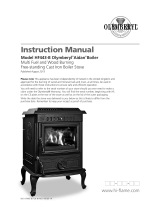Centrometal CentroPelet ZR12 Technical Instructions For Installation, Use And Maintenance
- Category
- Stoves
- Type
- Technical Instructions For Installation, Use And Maintenance
This manual is also suitable for
Centrometal CentroPelet ZR12 is a pellet stove that offers efficient and convenient heating solutions for various indoor spaces. Its advanced features and capabilities include:
-
Heating Capacity: The Centrometal CentroPelet ZR12 boasts an impressive heating capacity, making it suitable for spaces up to 260 cubic meters. It effectively distributes warmth throughout the room, ensuring a comfortable and cozy atmosphere.
-
Programmable Operation: Enjoy the convenience of programmable operation with the CentroPelet ZR12. You can pre-set the desired temperature and time intervals, allowing the stove to automatically maintain your preferred heating levels throughout the day or week.
Centrometal CentroPelet ZR12 is a pellet stove that offers efficient and convenient heating solutions for various indoor spaces. Its advanced features and capabilities include:
-
Heating Capacity: The Centrometal CentroPelet ZR12 boasts an impressive heating capacity, making it suitable for spaces up to 260 cubic meters. It effectively distributes warmth throughout the room, ensuring a comfortable and cozy atmosphere.
-
Programmable Operation: Enjoy the convenience of programmable operation with the CentroPelet ZR12. You can pre-set the desired temperature and time intervals, allowing the stove to automatically maintain your preferred heating levels throughout the day or week.












-
 1
1
-
 2
2
-
 3
3
-
 4
4
-
 5
5
-
 6
6
-
 7
7
-
 8
8
-
 9
9
-
 10
10
-
 11
11
-
 12
12
Centrometal CentroPelet ZR12 Technical Instructions For Installation, Use And Maintenance
- Category
- Stoves
- Type
- Technical Instructions For Installation, Use And Maintenance
- This manual is also suitable for
Centrometal CentroPelet ZR12 is a pellet stove that offers efficient and convenient heating solutions for various indoor spaces. Its advanced features and capabilities include:
-
Heating Capacity: The Centrometal CentroPelet ZR12 boasts an impressive heating capacity, making it suitable for spaces up to 260 cubic meters. It effectively distributes warmth throughout the room, ensuring a comfortable and cozy atmosphere.
-
Programmable Operation: Enjoy the convenience of programmable operation with the CentroPelet ZR12. You can pre-set the desired temperature and time intervals, allowing the stove to automatically maintain your preferred heating levels throughout the day or week.
Ask a question and I''ll find the answer in the document
Finding information in a document is now easier with AI
Related papers
-
Centrometal CAS-S-B-BS-vinyl Mounting instructions
-
Centrometal CentroPelet ZV 32 Installation, Use And Maintenance Instructions
-
Centrometal CentroPelet ZVB Series Technical Instructions
-
Centrometal CentroPelet Z12 Technical Instructions
-
Centrometal STB Technical Instructions
-
Centrometal TB Technical Instructions
-
Centrometal CentroPelet ZS10 Technical Instructions
-
Centrometal CentroPelet ZS10 Technical Instructions
Other documents
-
 Olimpia Splendid MIA 2-11 User manual
Olimpia Splendid MIA 2-11 User manual
-
Euroheat FB80 Gas Installation And Servicing
-
 Olymberyl HF443-B Aidan Boiler User manual
Olymberyl HF443-B Aidan Boiler User manual
-
 abc 23kW SUPER VULCANO User manual
abc 23kW SUPER VULCANO User manual
-
Hearth and Home Technologies CASTILE-CSB User manual
-
Quadra-Fire MTVERNON-AE-CWL User manual
-
Regency F39-NG User manual
-
Quadra-Fire 4300 WOOD STOVE SERIES User manual
-
Euroheat Nestor Martin Harmony H11 Installation, Servicing And Commissioning Instructions
-
United States Stove 24A Operating instructions














